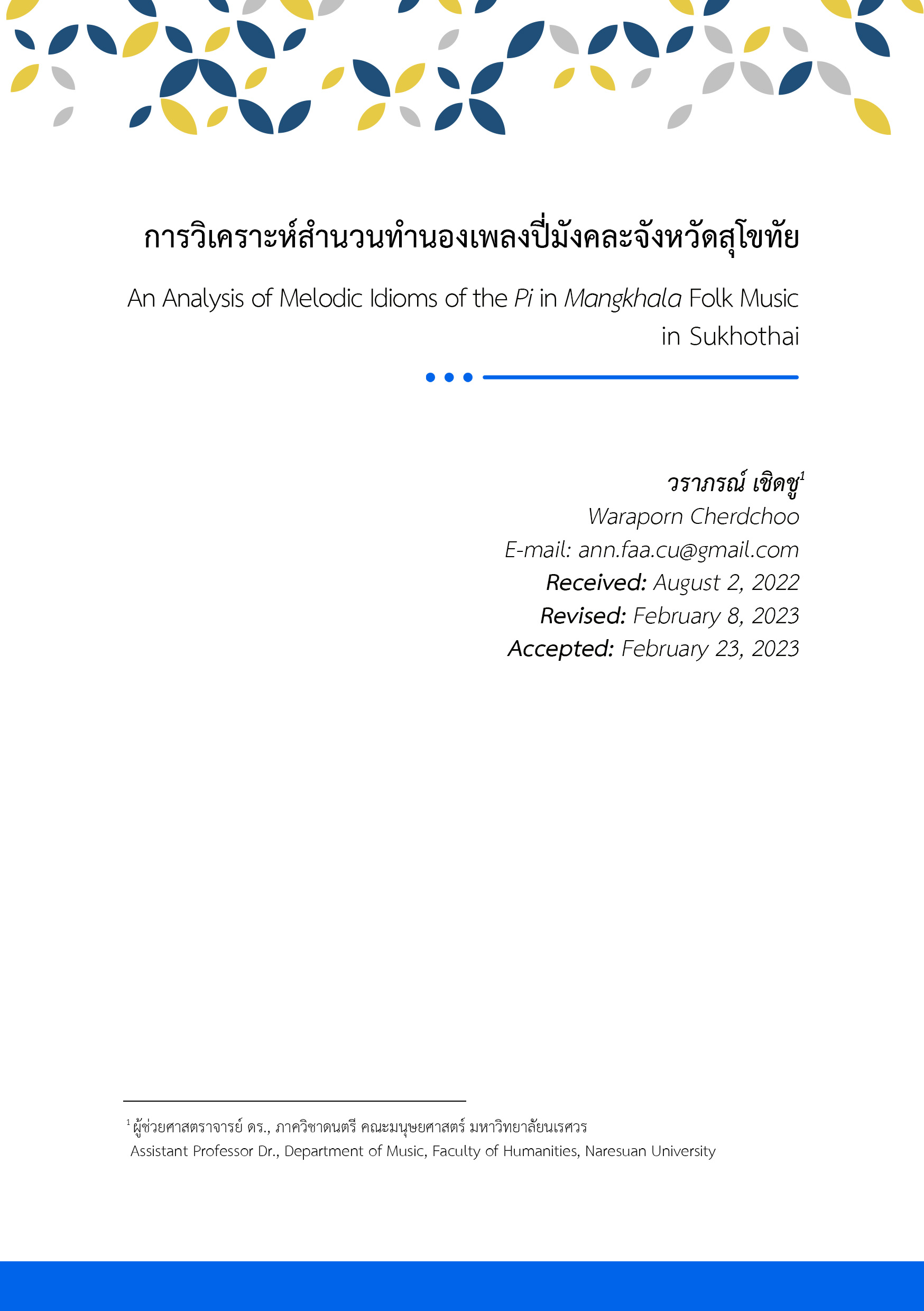An การวิเคราะห์สำนวนทำนองเพลงปี่มังคละจังหวัดสุโขทัย การวิเคราะห์สำนวนทำนองเพลงปี่มังคละจังหวัดสุโขทัย
Main Article Content
บทคัดย่อ
บทความวิจัยนี้มีวัตถุประสงค์เพื่อนำเสนอผลการวิเคราะห์สำนวนทำนองเพลง ปี่มังคละจังหวัดสุโขทัยจากศิลปิน จำนวน 2 สำนวน คือ นายอดุลย์ สิงเหม และนายทศพล แซ่เตีย ซึ่งเป็นการวิเคราะห์แบบเลือกประเด็น (Selective approach) ผลการวิจัยพบว่า ประเด็นการวิเคราะห์ปรากฏสำนวนทำนอง จำนวน 6 รูปแบบสำนวน สามารถจำแนกสำนวนทำนองเพลงปี่มังคละออกเป็น 2 กลุ่ม คือ กลุ่มที่ 1 สำนวนทำนองที่พบ ในทุกสำนวนเพลงปี่ จำนวน 4 สำนวน คือ 1) สำนวนการลากเสียง 2) สำนวนกระตุกเสียง 3) สำนวนสามพยางค์เสียง และสำนวนสี่พยางค์เสียง กลุ่มที่ 2 สำนวนทำนองที่พบเฉพาะสำนวนเพลงปี่ (ลักษณะเฉพาะบุคคล) จำนวน 2 สำนวน คือ 1) สำนวนลูกตกสำหรับเปลี่ยนกลุ่มทางเสียง และ 2) สำนวนการละเสียง จากสำนวนทำนองเพลงปี่มังคละจังหวัดสุโขทัยสามารถสะท้อนลักษณะเฉพาะของปรากฏการณ์ทางดนตรีได้เป็นอย่างดี โดยรูปแบบสำนวนทำนองมีวิธีการดำเนินทำนองที่สัมพันธ์แนวคิดหลัก คือ เป็นเครื่องดนตรีสำหรับการประโคม ทั้งการประโคมในลักษณะประกอบพิธีกรรมทางศาสนาและการประโคมในลักษณะการเฉลิมฉลองเพื่อความบันเทิง
Downloads
Article Details

อนุญาตภายใต้เงื่อนไข Creative Commons Attribution-NonCommercial-NoDerivatives 4.0 International License.
เอกสารอ้างอิง
Amod, N. (2021, March 24). Interview.
Chamni, K. (2021, April 9). Interview.
Coedes, G. (1983). Sukhothai Inscription. Bangkok: The Fine Arts Department.
Cherdchoo, W. (2022). An Analysis of Melodic Idioms of the Pi in Mangkhala Folk Music in Phitsanulok. Naresuan University (Mekong-Salween Civilization Studies Journal), 13(2), 175-200.
Khwanyuen W., Sukpramun P., & Traikasem S. (1992). Music and Art. Bangkok: The Fine Arts Department
Makkhrai, T., (Phra Maha). (2015). Method for promoting reconciliation using pi-klong mangkhala culture as a characteristic mechanism: In the case of the Sukhothai-speaking communities in the upper basin of the Nan River in Uttaradit Province. Veridian E-Journal, Silpakorn University (Humanities, Social Sciences and arts), 8(3), 249-266.
Princess Maha Chakri Sirindhorn Anthropology Centre. (2021, March 24). The Inscriptions in Thailand Database. Retrieved from https://db.sac.or.th/inscriptions/inscribe/detail/250
Saetia, T. (2021, March 18). Interview.
Singhem, A. (2021, March 24). Interview.
Wongthet, S. (1989). Singing Dancing Playing music: Music and Dance of Siamese. Bangkok: Phikhanet.
Wright, M. (1998). Foreigners who are crazy about Siam. Bangkok: Matichon.


